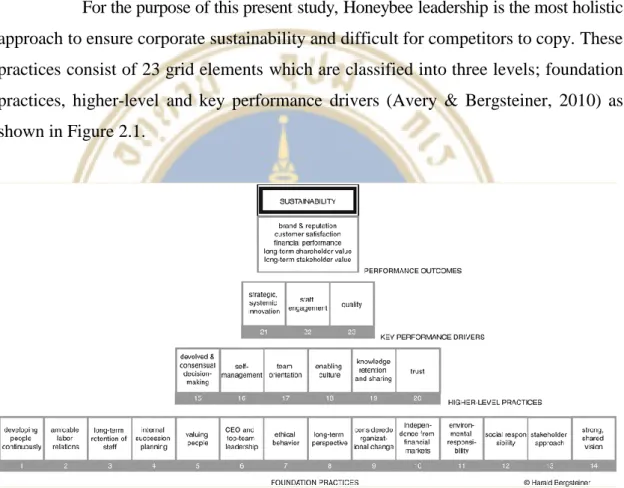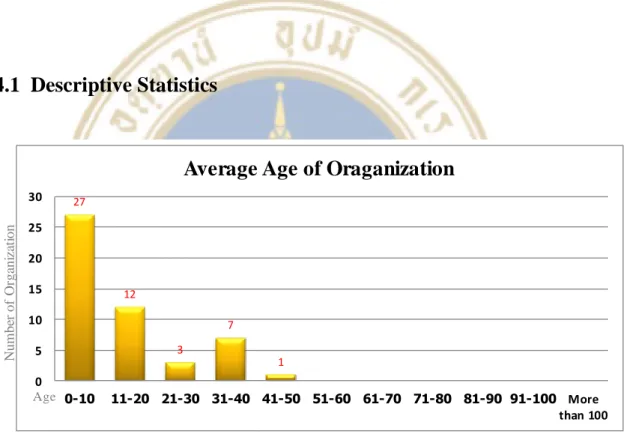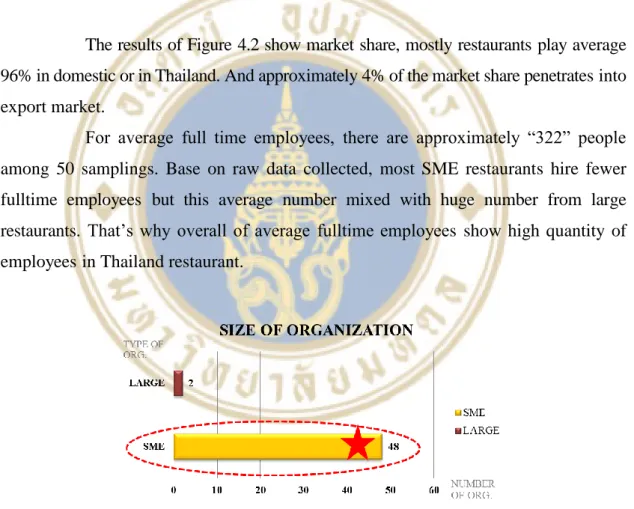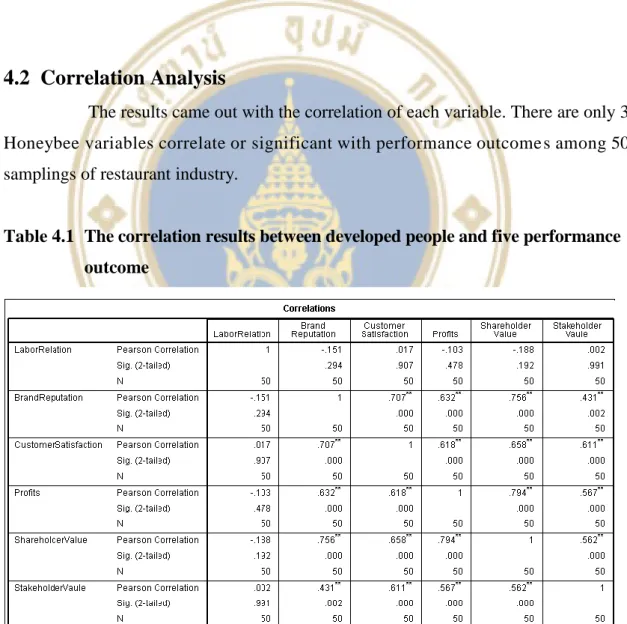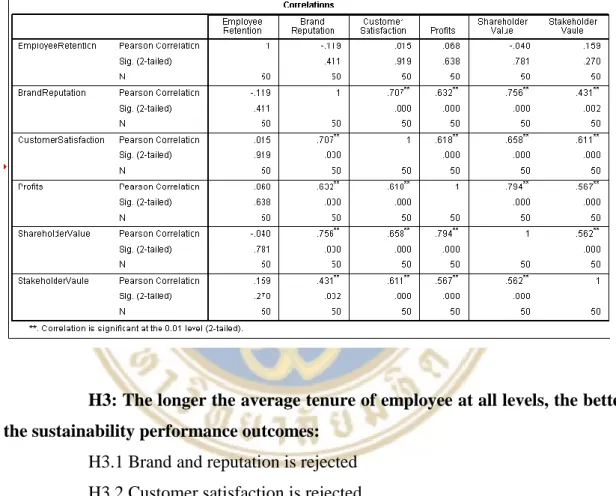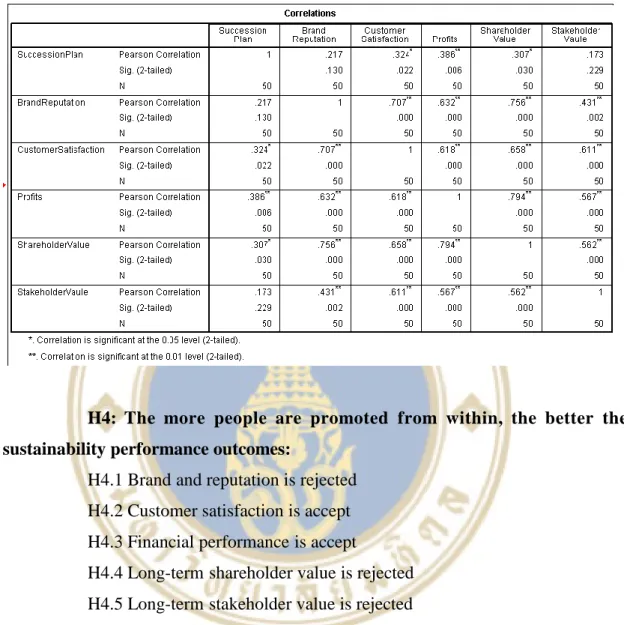This thematic paper summarizes honey bee management practices to examine the relationship between management practices in the restaurant industry in Thailand. Honeybee Sustainable Management The management practices of Avery&Bergsteiner, 2010 are composed of 23 grid elements and classified into 3 levels which are core practices, higher level practices and key performance factors to achieve the correlation of 5 sustainable performance results. Honeybee Leadership is a benchmark for ensuring sustainability in an organization that allows them to survive and thrive in good and crisis economies.
Expanded from Avery's (2005) Rhineland approach, the Honeybee management practice consists of 23 grid elements with the new name and focus on managing an organization to ensure long-term sustainable success and performance outcomes through both good and bad economies. In Europe, Rhineland capitalism is concerned with the long-term sustainability of the organization and the relationship between stakeholders (Albert, 1993). For the purposes of this study, Honeybee management is the most holistic approach to ensuring business sustainability and difficult for competitors to copy.
As the leadership of the Rhine and honey bees overlaps, discuss previous studies on the leadership of the Rhine and honey bees in Thailand. As shown in the table above, the results found that the two case studies of the consistency of the Honeybee Leadership framework on 15 network elements consist of people development, staff retention, staff evaluation, ethical behavior, long-term perspective, organizational change, social responsibility, stakeholders, vision , cultures, knowledge exchange and retention, trust, innovation, staff engagement and quality elements alike. Summarizing the general management of Rhineland and Honeybee from the case studies, the Thai organization operates quite according to the management approach of Rhineland and Honeybee, so these results highlight that sustainable management will sustain and enhance sustainable cooperation in Thailand.
Since sustainable leadership has gained support in Thailand as an approach to ensure corporate sustainability and little quantitative research has been conducted on business in the restaurant industry, the current study adopts the Honeybee leadership as a framework to examine the relationship between business practices of business in the examine proposed industry and their corporate sustainability performance outcomes.

RESEARCH METHODOLOGY
Methodology
Culture is weak except for a focus on short-term results that may or may not be shared 19 Knowledge sharing. Financial rewards are sufficient as motivators, emotional commitment is not expected. 23 Quality is embedded in the culture It is a matter of control. In order to capture more potential performance outcomes, they are expanded on 23 grid elements (Avery & Bergsteiner, 2010) and categorized into 3 levels which are core practices, higher level practices and key performance factors shown in Table 3.1.
To test this theory based on Honeybee's 23 variables and 5 performance outcomes, we set up a framework explanation that takes into account a set of facts or called a “Hypothesis” as follows.
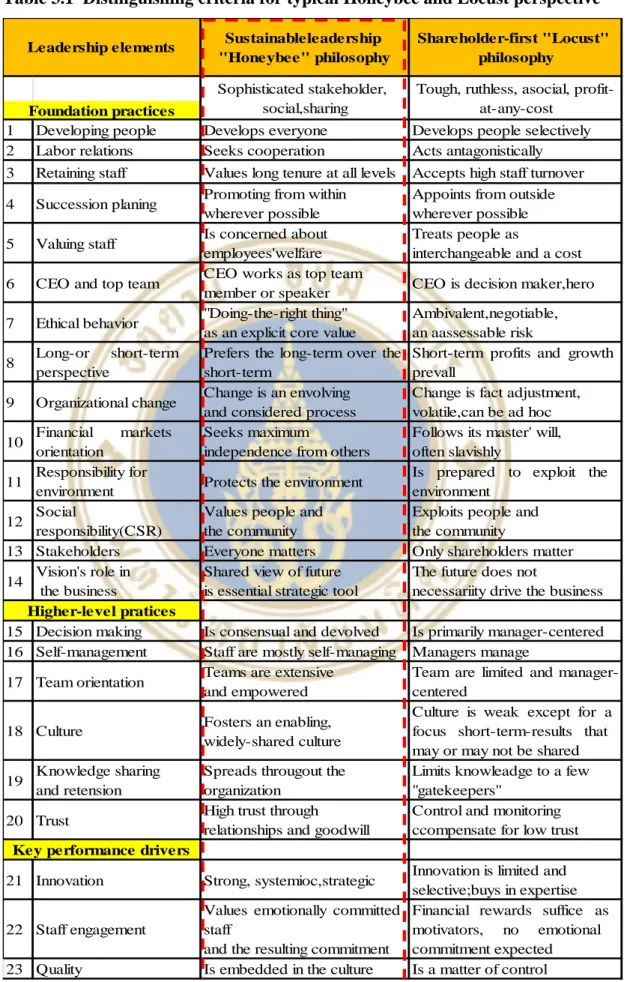
Hypothesis
H4.1 Brand and reputation H4.2 Customer satisfaction H4.3 Financial performance H4.4 Long-term shareholder value H4.5 Long-term stakeholder value. H5.1 Brand and reputation H5.2 Customer satisfaction H5.3 Financial performance H5.4 Long-term shareholder value H5.5 Long-term stakeholder value. H9.1 Brand and reputation H9.2 Customer satisfaction H9.3 Financial performance H9.4 Long-term shareholder value H9.5 Long-term stakeholder value.
H10.1 Brand and reputation H10.2 Customer satisfaction H10.3 Financial performance H10.4 Long-term shareholder value H10.5 Long-term stakeholder value. H11.1 Brand and reputation H11.2 Customer satisfaction H11.3 Financial performance H11.4 Long-term shareholder value H11.5 Long-term stakeholder value. H13.1 Brand and reputation H13.2 Customer satisfaction H13.3 Financial performance H13.4 Long-term shareholder value H13.5 Long-term stakeholder value.
H14.1 Brand and reputation H14.2 Customer satisfaction H14.3 Financial performance H14.4 Long-term shareholder value H14.5 Long-term stakeholder value. H15.1 Brand and reputation H15.2 Customer satisfaction H15.3 Financial performance H15.4 Long-term shareholder value H15.5 Long-term stakeholder value. H16.1 Brand and reputation H16.2 Customer satisfaction H16.3 Financial performance H16.4 Long-term shareholder value H16.5 Long-term stakeholder value.
H18.1 Brand and reputation H18.2 Customer satisfaction H18.3 Financial performance H18.4 Long-term shareholder value H18.5 Long-term stakeholder value. H19.1 Brand and reputation H19.2 Customer satisfaction H19.3 Financial performance H19.4 Long-term shareholder value H19.5 Long-term stakeholder value. H20.1 Brand and reputation H20.2 Customer satisfaction H20.3 Financial performance H20.4 Long-term shareholder value H20.5 Long-term stakeholder value.
H21.1 Brand and reputation H21.2 Customer satisfaction H21.3 Financial performance H21.4 Long-term shareholder value H21.5 Long-term stakeholder value. H22.1 Brand and reputation H22.2 Customer satisfaction H22.3 Financial performance H22.4 Long-term shareholder value H22.5 Long-term stakeholder value. H23.1 Brand and reputation H23.2 Customer satisfaction H23.3 Financial performance H23.4 Long-term shareholder value H23.5 Long-term stakeholder value.
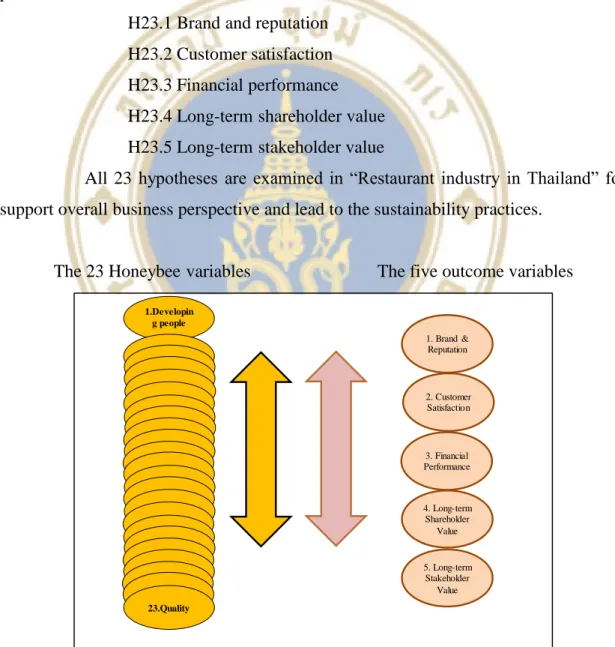
FINDINGS DISCUSSION
Descriptive Statistics
Average Age of Oraganization
Correlation Analysis
H1.1 Brand and reputation rejected H1.2 Customer satisfaction rejected H1.3 Financial performance accepted H1.4 Long-term shareholder value accepted H1.5 Long-term stakeholder value rejected. H5.1 Rejected brand and reputation H5.2 Rejected customer satisfaction H5.3 Rejected financial performance H5.4 Rejected long-term value of shareholders H5.5 Rejected long-term value of stakeholders. H7.1 Brand and reputation are accepted H7.2 Customer satisfaction is accepted H7.3 Financial performance is rejected H7.4 Long-term shareholder value is rejected H7.5 Long-term stakeholder value is accepted.
H8.1 Brand and reputation are rejected H8.2 Customer satisfaction is rejected H8.3 Financial performance is rejected H8.4 Long-term shareholder value is rejected H8.5 Long-term stakeholder value is rejected. H9.1 Brand and reputation are accepted H9.2 Customer satisfaction is rejected H9.3 Financial performance is rejected H9.4 Long-term shareholder value is accepted H9.5 Long-term stakeholder value is accepted. H10.1 Brand and reputation are rejected H10.2 Customer satisfaction is rejected H10.3 Financial performance is rejected H10.4 Long-term shareholder value is rejected H10.5 Long-term stakeholder value is rejected.
H11.1 Brand and reputation are rejected H11.2 Customer satisfaction is rejected H11.3 Financial performance is rejected H11.4 Long-term shareholder value is rejected H11.5 Long-term stakeholder value is rejected. H12.1 Brand and reputation are rejected H12.2 Customer satisfaction is rejected H12.3 Financial performance is rejected H12.4 Long-term shareholder value is rejected H12.5 Long-term stakeholder value is rejected. H13.1 Brand and reputation are rejected H13.2 Customer satisfaction is rejected H13.3 Financial performance is rejected H13.4 Long-term shareholder value is rejected H13.5 Long-term stakeholder value is accepted.
H15.1 Brand and reputation rejected H15.2 Customer satisfaction rejected H15.3 Financial performance rejected H15.4 Long-term shareholder value rejected H15.5 Long-term stakeholder value rejected. H16.1 Brand and reputation are rejected H16.2 Customer satisfaction is accepted H16.3 Financial performance is rejected H16.4 Long-term shareholder value is rejected H16.5 Long-term stakeholder value is rejected. H17.1 Brand and reputation rejected H17.2 Customer satisfaction rejected H17.3 Financial performance rejected H17.4 Long-term shareholder value rejected H17.5 Long-term stakeholder value rejected.
H18.1 Brand and reputation rejected H18.2 Customer satisfaction accepted H18.3 Financial performance rejected H18.4 Long-term shareholder value rejected H18.5 Long-term stakeholder value rejected. H19.1 Accept brand and reputation H19.2 Reject customer satisfaction H19.3 Reject financial performance H19.4 Reject long-term shareholder value H19.5 Reject long-term stakeholder value. H20.1 Brand and reputation rejected H20.2 Customer satisfaction accepted H20.3 Financial performance rejected H20.4 Long-term shareholder value rejected H20.5 Long-term stakeholder value rejected.
H21.1 Brand and reputation rejected H21.2 Customer satisfaction rejected H21.3 Financial performance rejected H21.4 Long-term shareholder value rejected H21.5 Long-term stakeholder value rejected. H22.1 Rejected brand and reputation H22.2 Rejected customer satisfaction H22.3 Rejected financial performance H22.4 Rejected long-term shareholder value H22.5 Rejected long-term stakeholder value.
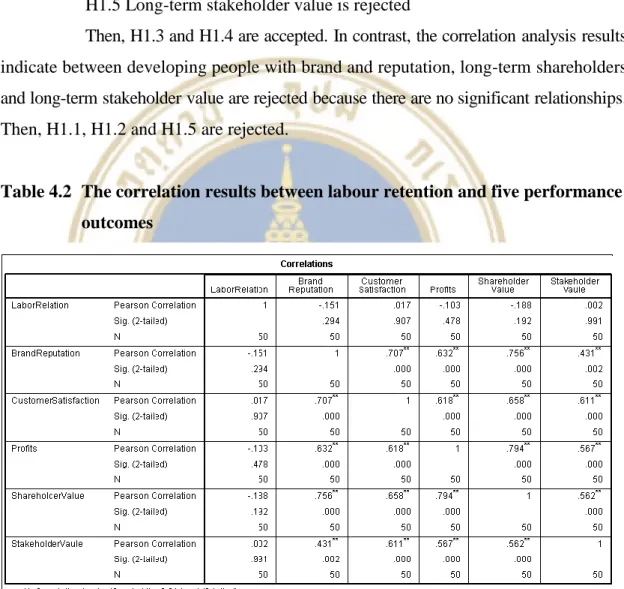
MANAGERIAL IMPLICATIONS
DISCUSSION
- Finding 3 Significant Results
- Finding 20 Non-Significant Results
To improve this area, the employer can be concerned about the labor relationship and the value of the union in order to promote sustainability in the organization. To improve this area, the employer or owner can treat the staff as a member of the family and concern for the care of the employees. To improve this area, the employer or owner can educate and maintain the core value in the company.
To improve this area, the employer or the owner can explain and make staff worry about what they are doing now will lead to the future performance outcome. To improve this area, employer can plan carefully to survive in any major changes. To improve this area, employer can consult with finance team before making a decision to maintain the restaurant in the long term.
So the restaurant owner can influence and implement this practice to be a core value in the organization. To improve this area, the restaurant owner can concern and take care of all the stakeholders, because everyone has an important role to build sustainability together. To improve this area, the employer can set a clear role vision and communicate it to every staff to accept so that they understand the essence of the business and perform well in the long run.
This is why there is non-significant practice and to improve this area, the owner must implement all decisions made using mutual decision making. To improve this area, the employer can give a chance to employee and they can show a hidden outstanding performance. To improve this area, the employer can standardize the job description and work procedure within the company.
To improve this area, the business owner or employer can organize a monthly or quarterly meeting to encourage staff to share ideas together. To improve this area, the owner can contribute to the involvement, such as doing CSR, which will lead to creating trust in the company. To improve this area, the business owner can value high quality in everything to encourage everyone and achieve the sustainability in the organization.
Conclusion
APPENDICES
